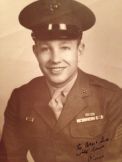Twice on this trip we were fed, and as I think back upon it, we didn’t get much food. The Japs gave each of us a box lunch consisting of two small rice balls, one slice of a pickled vegetable, dycon, (cross between a turnip and a radish), and a small piece of fish with a little sprig of seaweed.
We had been on this train about thirty-three hours when we arrived in Yokohama, Japan, on the afternoon of November 28, 1942. We were then marched from the railroad station to Prison Camp D 1.
We marched about one mile when we turned off the street and down a dirt road. Then we crossed over the railroad track and marched into our new prison camp. It was bleak and void of anything that looked like living quarters. The compound was inside a high board fence with three strands of barbed wire on top of the fence. The bbuilding [sic] that was to be our home was a huge warehouse or a “go-down” as they called it. It was about two hundred feet long and just as wide. There was not a window in the place, but there were four doors, one on each side of the building which were so immense that when one was opened, it was like letting in the whole outdoors.
Very soon we met our new Commandant, Lieutenant Masao Nichisawa, whom we nicknamed Banjo Eyes. Claude was the nickname we gave our camp interpreter, Pvt. First Class Hiroshi Kawamura. There were four more Japanese civilians working with the Japanese Army who gave us orders. They were Hatsuaki Hambe, better known as One Eye; Shonosuke Shishido, better known as Bull Dog; Sgt. Yoshitami Yama, known as the Pig; and last, but not least, Sukenobu Ikeda, known as Blacksleeves. We were informed by the Camp Commandant that we were prisoners of His Majesty, The Emperor, and that we were not to forget it.
This is the picture as the Commandant spoke to us. We were fresh from the tropics, and many of the men did not have any clothes except what they had on their backs. Those consisted mostly of khaki pants and trousers, and some of them had their pant legs cut off above the knees. Here we stood in frustration, shaking from the cold, as the temperature there in Yokohama was about the same as it is here in Kansas in December.
Next we were counted off in groups of fifty men and then marched to the Go-Down and shown where and how we were going to live. The building was divided into sections with aisles between each squad of men. The men on the ground floor had five feet of space between their heads and the area occupied by the squad that was stacked on top of them. I was on a top bunk so had plenty of head space as the ceiling in the building must have been twenty feet high. Our living space consisted of a straw mat that was laid down on the boards, and one shelf that was eight inches wide. It ran the full length of the squad area. We had five cotton blankets, a canvas bag, and a pillow, five inches by twelve inches, that was filled with rice husks. The mat measured five and one-half feet by two feet. Our squad area measured fifty feet by twenty feet with a five foot aisle taken out, so you see that wasn’t much space for fifty men to have to live in.
This camp D-1, formerly called Tokyo No.3, had seventy-six officers, consisting of British, Australian, and Dutch. There were 286 of us Americans, and the remaining 179 were English, Dutch, Australians and Javanese, making the total strength 541 men.
We were assigned numbers starting with 578 and continuing through 1040. Until we were given a number, they considered us mere captives without any identification, rather than prisoners. After we were assigned numbers, we listed our name, rank, serial number, and branch of service. There were twelve squads, and I was in squad number eleven. My number was 984.
The twelfth squad was short of men when we first started, but later it was filled with other P.O.W.s that were captured on Wake Island and Guam. Most of these people were civilians. One could truthfully say that this was an international camp. The names that appear at the end of the story are onew who were in this camp in April 1945. There is no way for me to know how many men died in Camp D-1.
The officers were in a separate part of the building, but a British Major C. Teasdel was made our representative, and did he ever have a job!
